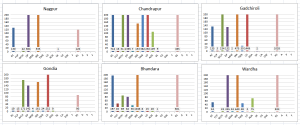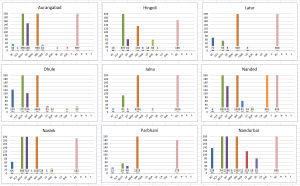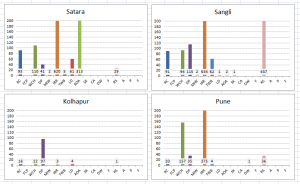What works, and doesn’t, in Maharashtra’s districts
In an exercise to help determine how reports of the MGNREGA (Mahatma Gandhi National Rural Employment Guarantee Act or Nrega) can inform us, I have used the records of what the programme calls ‘outcomes’ in the form of ‘physical assets’ created for the community (or conditional use by groups of individuals, depending on the kind of asset) over a financial year.
 The year is 2015-16 and the districts are those of Maharashtra (34, Mumbai excluded). There are at present 17 categories of physical assets and these are: rural connectivity, flood control and protection, water conservation and water harvesting, drought proofing, micro irrigation works, provision of irrigation, renovation of traditional water bodies, land development, any other activity approved, sewa kendra, coastal areas, rural drinking water, fisheries, rural sanitation, anganwadi, playground, food grain.
The year is 2015-16 and the districts are those of Maharashtra (34, Mumbai excluded). There are at present 17 categories of physical assets and these are: rural connectivity, flood control and protection, water conservation and water harvesting, drought proofing, micro irrigation works, provision of irrigation, renovation of traditional water bodies, land development, any other activity approved, sewa kendra, coastal areas, rural drinking water, fisheries, rural sanitation, anganwadi, playground, food grain.
 ‘Works’ are recorded under each kind of physical asset, with these classified as having been ‘approved’, ‘taken up’ and ‘completed’ (with ‘taken up’ presumably meaning commenced but incomplete at the end of the financial year). What matters therefore is to study those that have been completed, as the kind of community asset created and certified as being completed would serve to indicate what the community has decided it needs as a priority.
‘Works’ are recorded under each kind of physical asset, with these classified as having been ‘approved’, ‘taken up’ and ‘completed’ (with ‘taken up’ presumably meaning commenced but incomplete at the end of the financial year). What matters therefore is to study those that have been completed, as the kind of community asset created and certified as being completed would serve to indicate what the community has decided it needs as a priority.
 When so filtered, the number of completed physical assets in the 34 districts of Maharashtra for the year 2015-16 totalled 71,554 – a large number that helps describe why the Nrega records are so very voluminous: 1,376 ‘works’ completed every week in 34 districts, with tens of thousands of Nrega beneficiary individuals and households working to build, repair, revive, create them, and with a complex inventory of raw materials being required to be transported and paid for so that these works may take shape.
When so filtered, the number of completed physical assets in the 34 districts of Maharashtra for the year 2015-16 totalled 71,554 – a large number that helps describe why the Nrega records are so very voluminous: 1,376 ‘works’ completed every week in 34 districts, with tens of thousands of Nrega beneficiary individuals and households working to build, repair, revive, create them, and with a complex inventory of raw materials being required to be transported and paid for so that these works may take shape.
 What the list of completed works – type and number – describe is very instructive. Of the 17 categories, four (fisheries, anganwadi, playground and food grain) were recorded with not a single instance of having become a ‘work completed’ in any district. On the other hand, four kinds of physical assets accounted for a full 85% of the 71,554 works completed in Maharashtra’s 34 districts for 2015-16 and these were, in ascending order: drought proofing (8,110 and 11% of the total works), rural sanitation (12,234 and 17%), water conservation and water harvesting (14,384 and 20%), and provision of irrigation (26,496 and 37%).
What the list of completed works – type and number – describe is very instructive. Of the 17 categories, four (fisheries, anganwadi, playground and food grain) were recorded with not a single instance of having become a ‘work completed’ in any district. On the other hand, four kinds of physical assets accounted for a full 85% of the 71,554 works completed in Maharashtra’s 34 districts for 2015-16 and these were, in ascending order: drought proofing (8,110 and 11% of the total works), rural sanitation (12,234 and 17%), water conservation and water harvesting (14,384 and 20%), and provision of irrigation (26,496 and 37%).
 The popularity of the latter four can be well understood, as much for how they are all linked as for the precarious living conditions that every taluka in Maharashtra’s semi-arid districts face when the winter months end. These biases towards certain works but not others still do however need to be read with conditions, and keeping in mind that these are the works for but one financial year out of the last ten (albeit the definition of what constitutes an asset under Nrega has been altered and added to several times).
The popularity of the latter four can be well understood, as much for how they are all linked as for the precarious living conditions that every taluka in Maharashtra’s semi-arid districts face when the winter months end. These biases towards certain works but not others still do however need to be read with conditions, and keeping in mind that these are the works for but one financial year out of the last ten (albeit the definition of what constitutes an asset under Nrega has been altered and added to several times).
 The question that remains is: Maharashtra’s districts and blocks and villages occupy varying agro-ecological, hydrological and meteorological regions. Do their geographic and environmental circumstances not have a role to play in the decisions taken about what Nrega works should be taken up (and completed) as a priority over other kinds?
The question that remains is: Maharashtra’s districts and blocks and villages occupy varying agro-ecological, hydrological and meteorological regions. Do their geographic and environmental circumstances not have a role to play in the decisions taken about what Nrega works should be taken up (and completed) as a priority over other kinds?
The charts presented here in groups of districts arranged according to their location amongst the six agro-ecological regions that Maharashtra occupies, indicate whether the Nrega ‘works’ process takes cognisance of the fundamental environmental factors upon which the village (and so panchayat, taluka, district) rest. The charts have been constrained to 200 on the vertical axis in order to preserve readability – values are given for each ‘work’ recorded by each district. The abbreviations for the ‘works’ (horizontal axis) are for the full forms found in the second paragraph.
Leave a comment